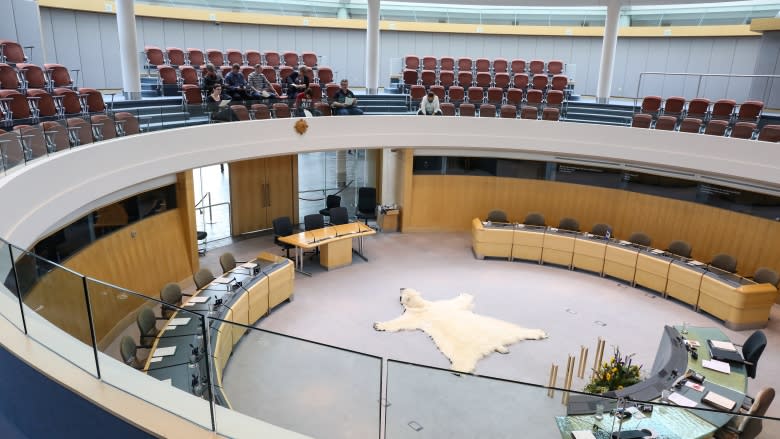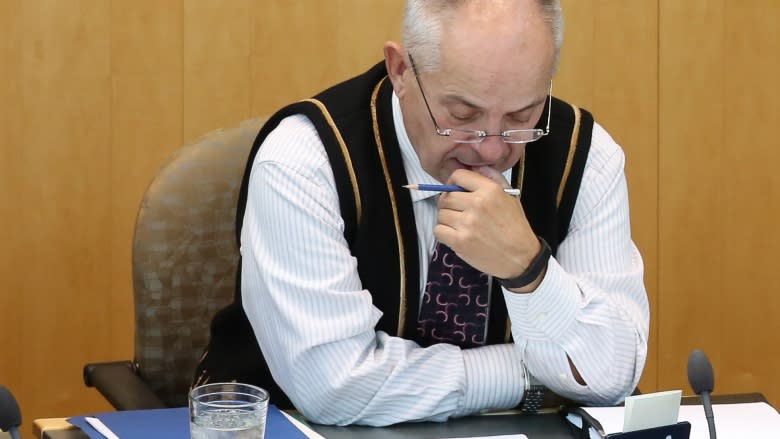6 things to know about N.W.T.'s infrastructure plans
For the second year in a row, the Northwest Territories legislature is budgeting an additional $50 million for infrastructure projects.
N.W.T.'s Finance Minister Michael Miltenberger released the capital budget last week and now members of the legislative assembly are reviewing what the territory plans to spend.
The money kicks in next April. However, debating the capital budget in the fall gives contractors and departments some extra time to plan in advance of the construction season, especially given the short window of warm weather for projects such as road paving.
Unlike some budgets, the capital budget doesn't attach dollar figures to specific items. This is to ensure bidders don't see information that would tip them off to how much the government is prepared to pay. Instead, there are general amounts for what will be spent by each department. However, plenty of details about the territory's financial plans are usually discussed during committee of the whole meetings in the legislative assembly.
Here are six things you need to know about the 2015-2016 capital expenditures.
1. Where's the money going? Roads, schools and hospitals, but mostly roads
Here are the highlights of this year's capital budget, according to Miltenberger's address to MLAs on Friday:
- $108 million for highways and winter roads
- $84 million for new health facilities, renovations and information system upgrades, including part of the Stanton Territorial Hospital revamp
- $28 million for community infrastructure
- $15 million for small capital projects across departments.
Here's the breakdown by department of where this year's money is going:
2. There's only so much money left to borrow
The territory's credit card is almost at its limit, with less than $100 million left in the $800 million borrowing limit.
This past summer's $55 million wildfire season and the $20 million power subsidy narrowed the gap to the debt ceiling, leaving little wiggle room for big projects or unforeseen costs.
The federal government raised the borrowing limit in 2012, in part to allow for projects such as the Inuvik to Tuktoyaktuk highway. Since then, the finance minister has been lobbying to raise it even higher to $1.8 billion. That could help build projects such as the Mackenzie Valley Fibre Optic Link or connecting transmission grids.
In the legislature, Range Lake MLA Daryl Dolynny questioned whether it was responsible of the government to raise the borrowing limit in order to take on more debt.
"Although we hit the wall of worry some time ago, apparently all we have to do is fill out the Joe Oliver American Express Card application form and presto, we're back inking those cheques."
"This is not a way to deal with debt management," Dolynny told CBC News. "I think history is going to judge us as being potentially the assembly that put us in the corner by our spending. I'm really, really, gravely concerned."
It's the government's policy to fund half of its infrastructure spending with operating surpluses, which limits what can be spent. Next year Miltenberger says the plan is to scale back infrastructure spending, as it was during the first two years of this government.
But there may be some hope for tackling the territory's estimated $3 billion infrastructure deficit. Miltenberger says the territory and municipalities are also hoping to tap into the New Building Canada fund, $258 million over the next decade. He says he'll be bringing forward a proposal for how to spend this in February.
3. It's a post-devolution world. Well, kind of
Resource royalties are now going directly to the territory but they're not being spent yet and the economic outlook isn't as rosy as hoped. Speaking in the house, Miltenberger said expected revenues are down slightly this year due to poor economic activity.
On average, he's expecting $113 million annually over the next five years, compared to the $120 million that was anticipated. Half of that will go to the federal government, a quarter of the territory's share goes directly to aboriginal governments and a quarter of the remaining money will be put in a Heritage Fund. That leaves approximately $31 million to be spend on paying down debt, future big ticket items and infrastructure. Not exactly rolling in cash.
Nonetheless, the territory is still optimistic about expanding its population. Two thousand new residents would increase the amount of transfer payments from Ottawa and with a larger population, the territory could keep a larger share of those resource revenues. However, as of June the population was still declining, with close to 400 people moving out of the territory in the first four months of this year. The exodus to the rest of Canada hasn't been that large since 2010.
Miltenberger says they're working to minimize the number of people who fly in and out from the mines and trying to fill vacancies in the public service. He says Industry, Tourism and Investment's upcoming Energy Charette will look at energy generation and lowering costs of power, which will be appealing to potential residents.
4. Some MLAs say the territory is pouring too much into roads
Some members of the legislative assembly say the territory is spending money it doesn't have. Bob Bromley, member for Weledeh, who typically has views that are far from Conservative, says the government is pouring more than necessary into infrastructure.
"Northerners have a record of achievement in the absence of infrastructure as long as they are given appropriate supports, and this government's approach is to throw money at infrastructure, particularly to try and attract mega development when we know the global economy is not there."
Bromley calls the capital estimates incomplete because year and year there are capital costs that come in the form of supplementary appropriations. Last year the territory budgeted $222 million for infrastructure and in actuality it spent $322 million.
Wendy Bisaro, who represents Frame Lake, questions why a third of the budget is going to highways and winter roads.
"The focus in this budget, for me, is weighted too heavily on economic development and on transportation projects," she said. "We haven't put enough money into infrastructure, which is going to assist our people. I’m thinking about schools, I’m thinking about health structure, and I know there’s some money in there, but I don’t think the same emphasis is on those kinds of infrastructure investments as it is in highways and economic development."
5. Plans for new investments in wildfire preparedness
This year's wildfire season battered the financial books, costing three per cent of the overall budget. The capital plans includes buying eight new air tankers. The Air Tractor At-802AF Fire Bosses are expected to cost $27 million. Miltenberger says the current fleet of CL-215s are so outdated upgrading them would cost $120 million.
"If the new normal, God forbid, is what we saw last summer, then we are definitely going to want to make sure we can assure the people of the Northwest Territories that we have the tools ready for the people, men and women in the air and on the ground — the thin line that protects us from the ravages of forest fires."
However, while the territory is in line for the new tankers, it may take years for the new planes to arrive.
The capital plans also include a territorial fire centre in Fort Smith, a new facility for wildfire crews in Fort Simpson, as well as upgrades to the air tanker bases in Norman Wells and Hay River. There will be network upgrades, new lightning sensors and new lookout towers near Enterprise and Schiltee Rock, which is close to Fort McPherson.
6. Inuvik to Tuk Highway gets a cash advance
On Friday, Miltenberger alluded to giving the Inuvik to Tuktoyaktuk highway project a $40 million cash advance in the form of a supplementary appropriation. This will be in addition to the approximately $20 million that's already pegged for the mega project in this capital budget.
Miltenberger says approving the money now will ensure the work won't stop if money runs out in January. Construction on the 137-kilometre all-weather road can only ramp up when the ground freezes, so the construction season runs mid-November till late April. He says approving the money now may also allow the project to finish up in three years, instead of four.
But Dolynny is questioning whether this could bump other projects in the long line for capital money.
"We’re now taking money from a future budget season and accelerating it here, which is of concern for a few of us here."
For ongoing coverage of the legislative assembly session, you can follow reporter Elizabeth McMillan on twitter.



